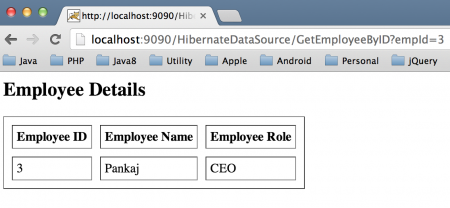欢迎来到Hibernate Tomcat JNDI DataSource示例教程。我们已经看过如何在独立的Java应用程序中使用Hibernate ORM工具,今天我们将学习如何在Tomcat Servlet容器中使用Hibernate与DataSource。在Web应用程序中使用Hibernate非常简单,我们只需要在Hibernate配置文件中配置DataSource属性即可。首先,我们需要在Tomcat容器中设置测试数据库和JNDI DataSource。
Hibernate DataSource JNDI示例数据库设置
I am using MySQL for my example, below script is executed to create a simple table and insert some values into it. employee.sql
CREATE TABLE `Employee` (
`id` int(11) unsigned NOT NULL AUTO_INCREMENT,
`name` varchar(20) DEFAULT NULL,
`role` varchar(20) DEFAULT NULL,
`insert_time` datetime DEFAULT NULL,
PRIMARY KEY (`id`)
) ENGINE=InnoDB AUTO_INCREMENT=26 DEFAULT CHARSET=utf8;
INSERT INTO `Employee` (`id`, `name`, `role`, `insert_time`)
VALUES
(3, 'Pankaj', 'CEO', now());
INSERT INTO `Employee` (`id`, `name`, `role`, `insert_time`)
VALUES
(14, 'David', 'Developer', now());
数据库模式名称为TestDB。
Tomcat JNDI DataSource配置
要配置Tomcat容器以初始化DataSource,我们需要对tomcat的server.xml和context.xml文件进行一些更改。server.xml
<Resource name="jdbc/MyLocalDB"
global="jdbc/MyLocalDB"
auth="Container"
type="javax.sql.DataSource"
driverClassName="com.mysql.jdbc.Driver"
url="jdbc:mysql://localhost:3306/TestDB"
username="pankaj"
password="pankaj123"
maxActive="100"
maxIdle="20"
minIdle="5"
maxWait="10000"/>
将以上资源添加到GlobalNamingResources元素中。context.xml
<ResourceLink name="jdbc/MyLocalDB"
global="jdbc/MyLocalDB"
auth="Container"
type="javax.sql.DataSource" />
将上述 ResourceLink 添加到 context.xml 文件中,这是必需的,以便应用程序可以访问名称为 jdbc/MyLocalDB 的 JNDI 资源。只需重新启动服务器,您就不应该在 tomcat 服务器日志中看到任何错误。如果存在任何错误的配置,例如密码错误,您将在服务器日志中得到相应的异常。您还需要确保 MySQL 驱动程序 jar 文件位于 tomcat lib 目录中,否则 tomcat 将无法创建数据库连接,并且您将在日志中收到 ClassNotFoundException。现在我们的数据库和 tomcat 服务器 JNDI 设置已准备就绪,让我们开始创建使用 hibernate 的 web 应用程序。
Hibernate 数据源示例动态 Web 项目
在Eclipse中创建一个动态Web项目,然后将其配置为Maven项目。我们的最终项目结构将如下图所示。注意,我正在使用Tomcat-7来部署我的项目,并将其添加到构建路径中,这样我们就不需要单独添加Servlet API依赖项到我们的项目中。Tomcat-7支持Servlet 3规范,我们将使用注解来创建我们的Servlet。如果你对Servlet 3注解不熟悉,你应该查看初学者Servlet教程。让我们逐个查看每个组件。
Hibernate Maven依赖
我们最终的pom.xml文件如下所示。
<project xmlns="https://maven.apache.org/POM/4.0.0" xmlns:xsi="https://www.w3.org/2001/XMLSchema-instance"
xsi:schemaLocation="https://maven.apache.org/POM/4.0.0 https://maven.apache.org/xsd/maven-4.0.0.xsd">
<modelVersion>4.0.0</modelVersion>
<groupId>HibernateDataSource</groupId>
<artifactId>HibernateDataSource</artifactId>
<version>0.0.1-SNAPSHOT</version>
<packaging>war</packaging>
<dependencies>
<dependency>
<groupId>org.hibernate</groupId>
<artifactId>hibernate-core</artifactId>
<version>4.3.5.Final</version>
</dependency>
<dependency>
<groupId>mysql</groupId>
<artifactId>mysql-connector-java</artifactId>
<version>5.0.5</version>
<scope>provided</scope>
</dependency>
</dependencies>
<build>
<plugins>
<plugin>
<artifactId>maven-war-plugin</artifactId>
<version>2.3</version>
<configuration>
<warSourceDirectory>WebContent</warSourceDirectory>
<failOnMissingWebXml>false</failOnMissingWebXml>
</configuration>
</plugin>
<plugin>
<artifactId>maven-compiler-plugin</artifactId>
<version>3.1</version>
<configuration>
<source>1.7</source>
<target>1.7</target>
</configuration>
</plugin>
</plugins>
<finalName>${project.artifactId}</finalName>
</build>
</project>
I am using Hibernate latest version 4.3.5.Final, hibernate-core dependency is added for Hibernate. mysql-connector-java dependency is added because we are using MySQL database, although scope is provided because it’s already part of the tomcat container libraries. Even if we don’t add MySQL driver dependencies, our project will compile and run fine. However it’s better to include it so that if someone will look into the project dependencies, it will be clear that we are using MySQL database.
Hibernate数据源配置
我们的Hibernate配置文件与数据源如下所示。 hibernate.cfg.xml
<?xml version="1.0" encoding="UTF-8"?>
<!DOCTYPE hibernate-configuration PUBLIC
"-//Hibernate/Hibernate Configuration DTD 3.0//EN"
"https://hibernate.org/dtd/hibernate-configuration-3.0.dtd">
<hibernate-configuration>
<session-factory>
<property name="hibernate.connection.driver_class">com.mysql.jdbc.Driver</property>
<property name="hibernate.dialect">org.hibernate.dialect.MySQLDialect</property>
<property name="hibernate.connection.datasource">java:comp/env/jdbc/MyLocalDB</property>
<property name="hibernate.current_session_context_class">thread</property>
<!-- Mapping with model class containing annotations -->
<mapping class="com.journaldev.servlet.hibernate.model.Employee"/>
</session-factory>
</hibernate-configuration>
hibernate.connection.datasource属性用于提供数据源的名称,该数据源将被Hibernate用于数据库操作。
Hibernate数据源示例模型类
正如您在Hibernate配置文件中所看到的,我们在模型类Employee中使用了注解。我们的模型Bean如下所示。Employee.java
package com.journaldev.servlet.hibernate.model;
import java.util.Date;
import javax.persistence.Column;
import javax.persistence.Entity;
import javax.persistence.GeneratedValue;
import javax.persistence.GenerationType;
import javax.persistence.Id;
import javax.persistence.Table;
import javax.persistence.UniqueConstraint;
@Entity
@Table(name="Employee",
uniqueConstraints={@UniqueConstraint(columnNames={"ID"})})
public class Employee {
@Id
@GeneratedValue(strategy=GenerationType.IDENTITY)
@Column(name="ID", nullable=false, unique=true, length=11)
private int id;
@Column(name="NAME", length=20, nullable=true)
private String name;
@Column(name="ROLE", length=20, nullable=true)
private String role;
@Column(name="insert_time", nullable=true)
private Date insertTime;
public int getId() {
return id;
}
public void setId(int id) {
this.id = id;
}
public String getName() {
return name;
}
public void setName(String name) {
this.name = name;
}
public String getRole() {
return role;
}
public void setRole(String role) {
this.role = role;
}
public Date getInsertTime() {
return insertTime;
}
public void setInsertTime(Date insertTime) {
this.insertTime = insertTime;
}
}
模型Bean与我们在Hibernate入门教程中使用的相同,如果您对所使用的任何注解感到困惑,应该查看一下。
Hibernate数据源Tomcat JNDI Servlet监听器
由于我们需要初始化Hibernate SessionFactory以便在应用程序中使用它,并且在Web应用程序销毁时需要销毁SessionFactory。因此,在ServletContextListener实现中执行此操作是最佳选择。HibernateSessionFactoryListener.java
package com.journaldev.servlet.hibernate.listener;
import javax.servlet.ServletContextEvent;
import javax.servlet.ServletContextListener;
import javax.servlet.annotation.WebListener;
import org.hibernate.SessionFactory;
import org.hibernate.boot.registry.StandardServiceRegistryBuilder;
import org.hibernate.cfg.Configuration;
import org.hibernate.service.ServiceRegistry;
import org.jboss.logging.Logger;
@WebListener
public class HibernateSessionFactoryListener implements ServletContextListener {
public final Logger logger = Logger.getLogger(HibernateSessionFactoryListener.class);
public void contextDestroyed(ServletContextEvent servletContextEvent) {
SessionFactory sessionFactory = (SessionFactory) servletContextEvent.getServletContext().getAttribute("SessionFactory");
if(sessionFactory != null && !sessionFactory.isClosed()){
logger.info("Closing sessionFactory");
sessionFactory.close();
}
logger.info("Released Hibernate sessionFactory resource");
}
public void contextInitialized(ServletContextEvent servletContextEvent) {
Configuration configuration = new Configuration();
configuration.configure("hibernate.cfg.xml");
logger.info("Hibernate Configuration created successfully");
ServiceRegistry serviceRegistry = new StandardServiceRegistryBuilder().applySettings(configuration.getProperties()).build();
logger.info("ServiceRegistry created successfully");
SessionFactory sessionFactory = configuration
.buildSessionFactory(serviceRegistry);
logger.info("SessionFactory created successfully");
servletContextEvent.getServletContext().setAttribute("SessionFactory", sessionFactory);
logger.info("Hibernate SessionFactory Configured successfully");
}
}
如果您对Servlet监听器不熟悉,请阅读Servlet监听器教程。
Hibernate Tomcat JNDI示例Servlet实现
让我们编写一个简单的Servlet,在这里我们将员工ID作为请求参数传递,并且它将从数据库打印出员工信息,显然我们将使用Hibernate来查询数据库并获取员工信息。GetEmployeeByID.java
package com.journaldev.servlet.hibernate;
import java.io.IOException;
import java.io.PrintWriter;
import javax.servlet.ServletException;
import javax.servlet.annotation.WebServlet;
import javax.servlet.http.HttpServlet;
import javax.servlet.http.HttpServletRequest;
import javax.servlet.http.HttpServletResponse;
import org.hibernate.Session;
import org.hibernate.SessionFactory;
import org.hibernate.Transaction;
import org.jboss.logging.Logger;
import com.journaldev.servlet.hibernate.model.Employee;
@WebServlet("/GetEmployeeByID")
public class GetEmployeeByID extends HttpServlet {
private static final long serialVersionUID = 1L;
public final Logger logger = Logger.getLogger(GetEmployeeByID.class);
protected void doGet(HttpServletRequest request, HttpServletResponse response) throws ServletException, IOException {
int empId = Integer.parseInt(request.getParameter("empId"));
logger.info("Request Param empId="+empId);
SessionFactory sessionFactory = (SessionFactory) request.getServletContext().getAttribute("SessionFactory");
Session session = sessionFactory.getCurrentSession();
Transaction tx = session.beginTransaction();
Employee emp = (Employee) session.get(Employee.class, empId);
tx.commit();
PrintWriter out = response.getWriter();
response.setContentType("text/html");
if(emp != null){
out.print("<html><body><h2>Employee Details</h2>");
out.print("<table border=\"1\" cellspacing=10 cellpadding=5>");
out.print("<th>Employee ID</th>");
out.print("<th>Employee Name</th>");
out.print("<th>Employee Role</th>");
out.print("<tr>");
out.print("<td>" + empId + "</td>");
out.print("<td>" + emp.getName() + "</td>");
out.print("<td>" + emp.getRole() + "</td>");
out.print("</tr>");
out.print("</table></body><br/>");
out.print("</html>");
}else{
out.print("<html><body><h2>No Employee Found with ID="+empId+"</h2></body></html>");
}
}
}
这是一个非常简单的Servlet类,我正在使用@WebServlet注解来为其提供URI模式。
测试Hibernate DataSource Tomcat JNDI示例应用程序
我们的应用程序现在已经准备好了,只需将其导出为war文件并部署到tomcat容器中。以下是当我们调用应用程序servlet时的一些屏幕截图。
 请注意,我在请求URL查询字符串中传递了empId请求参数。您还将在服务器日志中看到我们应用程序生成的日志。
请注意,我在请求URL查询字符串中传递了empId请求参数。您还将在服务器日志中看到我们应用程序生成的日志。
May 08, 2014 8:14:16 PM org.hibernate.cfg.Configuration configure
INFO: HHH000043: Configuring from resource: hibernate.cfg.xml
May 08, 2014 8:14:16 PM org.hibernate.cfg.Configuration getConfigurationInputStream
INFO: HHH000040: Configuration resource: hibernate.cfg.xml
May 08, 2014 8:14:16 PM org.hibernate.cfg.Configuration doConfigure
INFO: HHH000041: Configured SessionFactory: null
May 08, 2014 8:14:16 PM com.journaldev.servlet.hibernate.listener.HibernateSessionFactoryListener contextInitialized
INFO: Hibernate Configuration created successfully
May 08, 2014 8:14:16 PM com.journaldev.servlet.hibernate.listener.HibernateSessionFactoryListener contextInitialized
INFO: ServiceRegistry created successfully
May 08, 2014 8:14:16 PM org.hibernate.dialect.Dialect <init>
INFO: HHH000400: Using dialect: org.hibernate.dialect.MySQLDialect
May 08, 2014 8:14:17 PM org.hibernate.engine.jdbc.internal.LobCreatorBuilder useContextualLobCreation
INFO: HHH000423: Disabling contextual LOB creation as JDBC driver reported JDBC version [3] less than 4
May 08, 2014 8:14:17 PM org.hibernate.engine.transaction.internal.TransactionFactoryInitiator initiateService
INFO: HHH000399: Using default transaction strategy (direct JDBC transactions)
May 08, 2014 8:14:17 PM org.hibernate.hql.internal.ast.ASTQueryTranslatorFactory <init>
INFO: HHH000397: Using ASTQueryTranslatorFactory
May 08, 2014 8:14:17 PM com.journaldev.servlet.hibernate.listener.HibernateSessionFactoryListener contextInitialized
INFO: SessionFactory created successfully
May 08, 2014 8:14:17 PM com.journaldev.servlet.hibernate.listener.HibernateSessionFactoryListener contextInitialized
INFO: Hibernate SessionFactory Configured successfully
May 08, 2014 8:14:32 PM com.journaldev.servlet.hibernate.GetEmployeeByID doGet
INFO: Request Param empId=3
May 08, 2014 8:15:22 PM com.journaldev.servlet.hibernate.GetEmployeeByID doGet
INFO: Request Param empId=3
如果您将应用程序取消部署或停止服务器,则将在服务器日志中看到销毁SessionFactory的日志。
May 08, 2014 11:31:16 PM com.journaldev.servlet.hibernate.listener.HibernateSessionFactoryListener contextDestroyed
INFO: Closing sessionFactory
May 08, 2014 11:31:16 PM com.journaldev.servlet.hibernate.listener.HibernateSessionFactoryListener contextDestroyed
INFO: Released Hibernate sessionFactory resource
这就是针对tomcat容器的Hibernate DataSource示例,我希望这很容易理解和实现。从下面的链接下载示例项目并进行更多学习。
Source:
https://www.digitalocean.com/community/tutorials/hibernate-tomcat-jndi-datasource-example-tutorial













